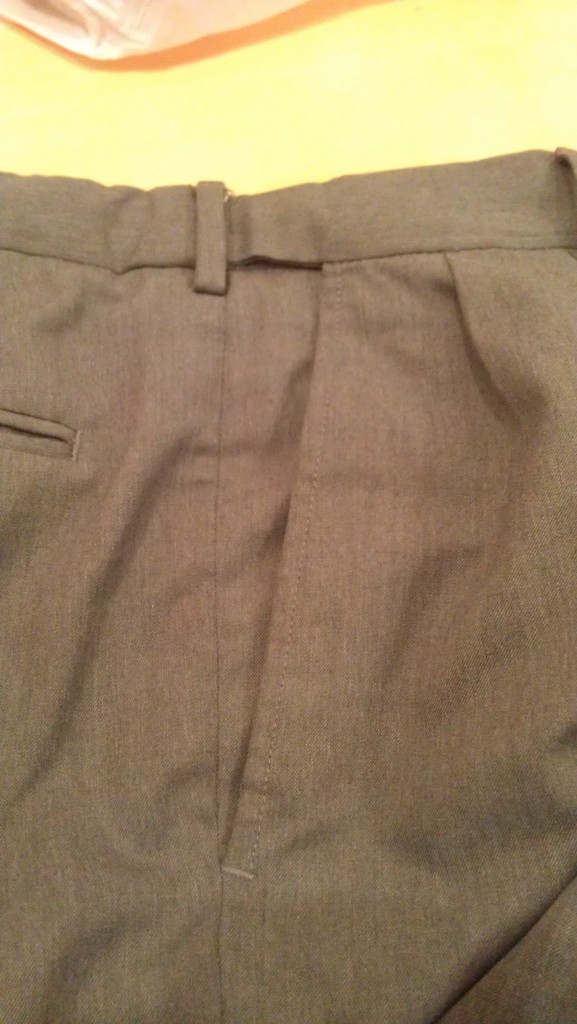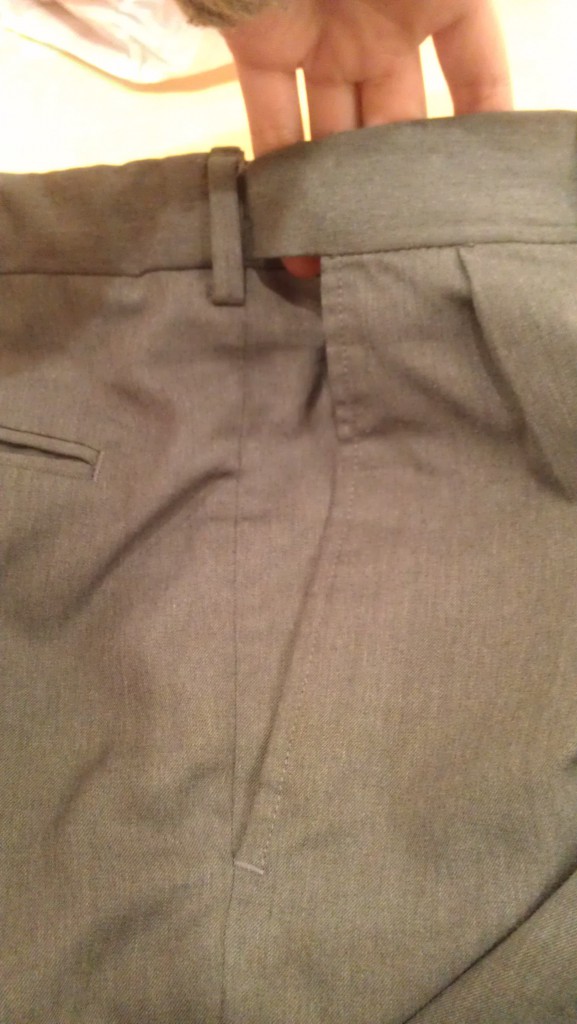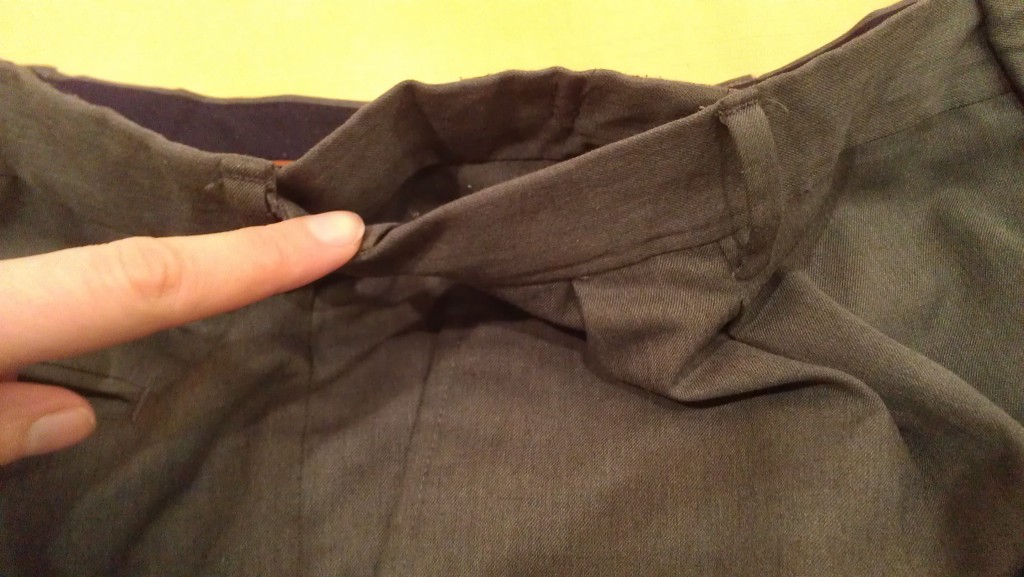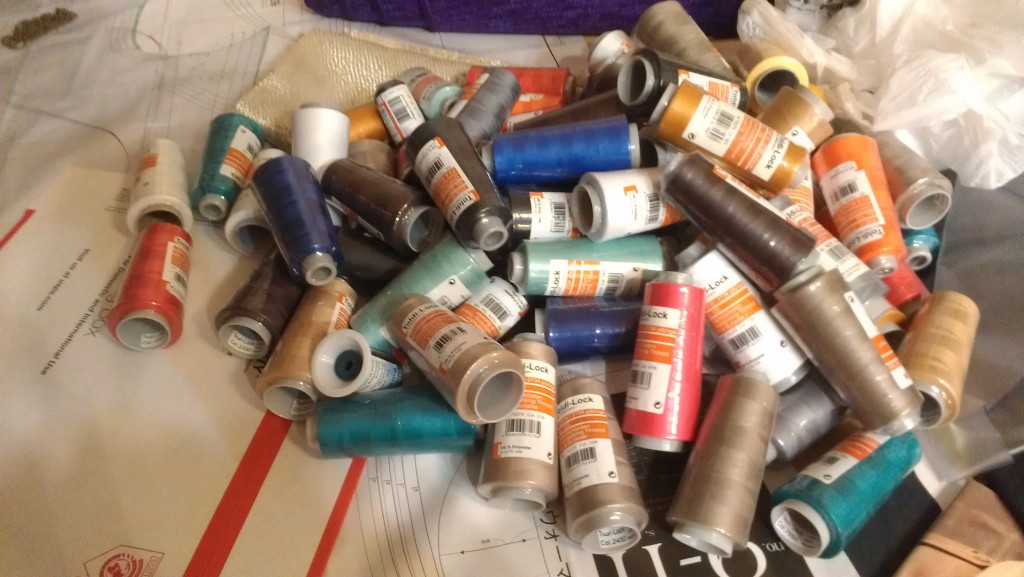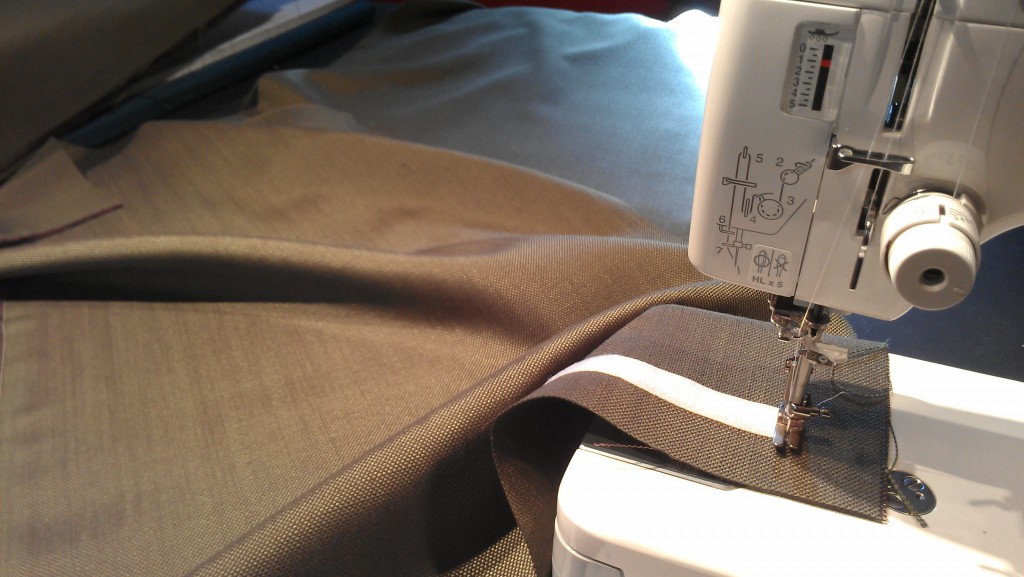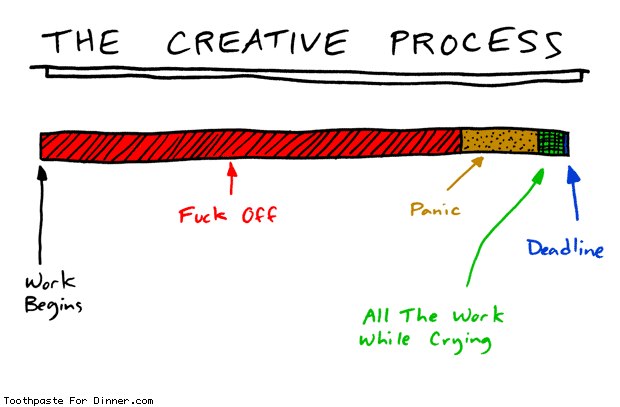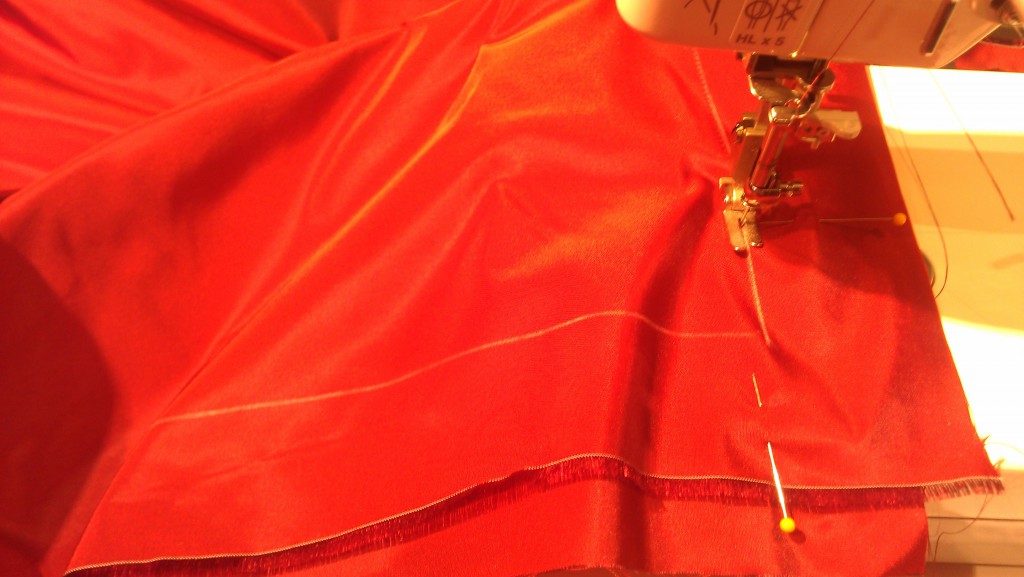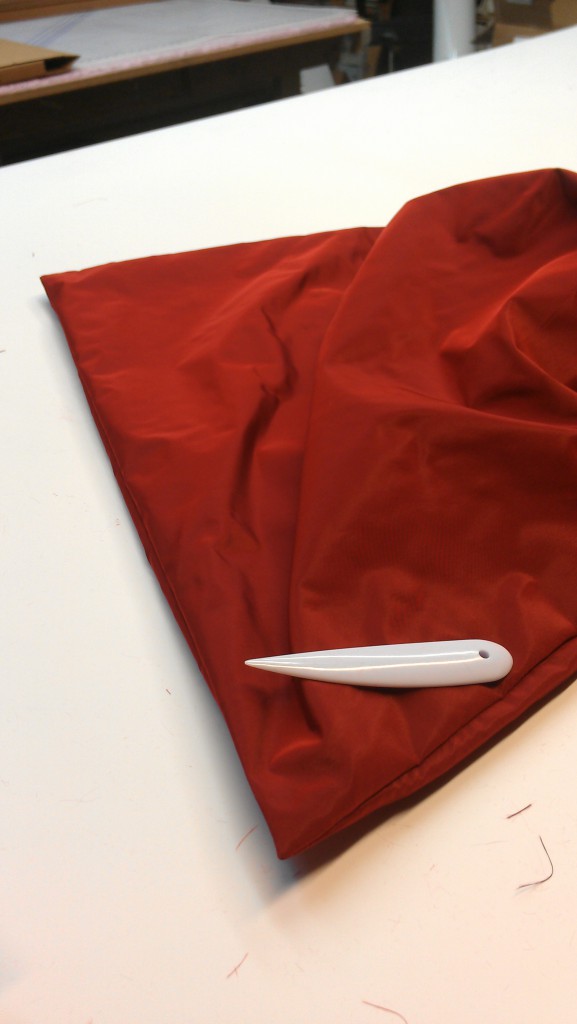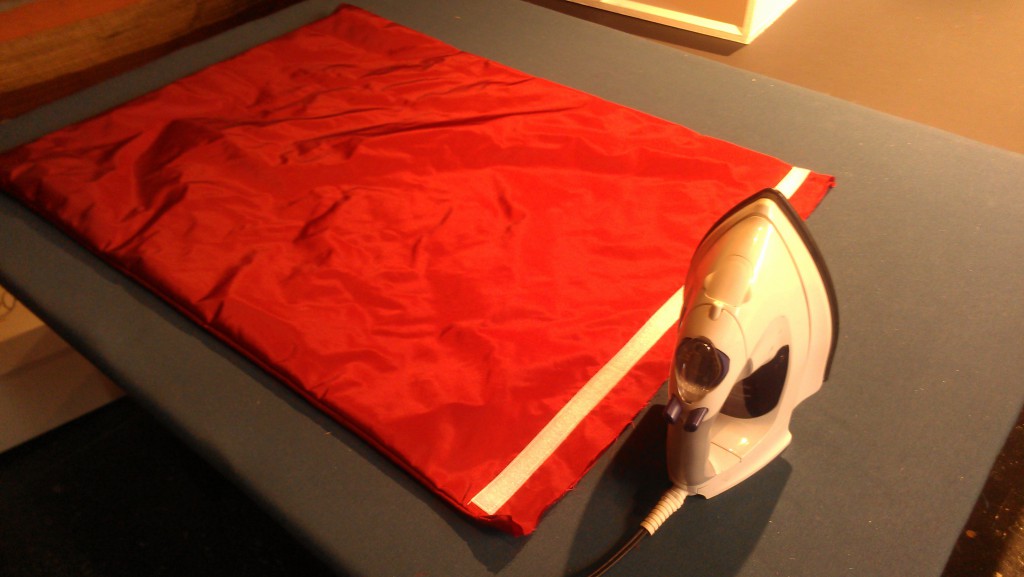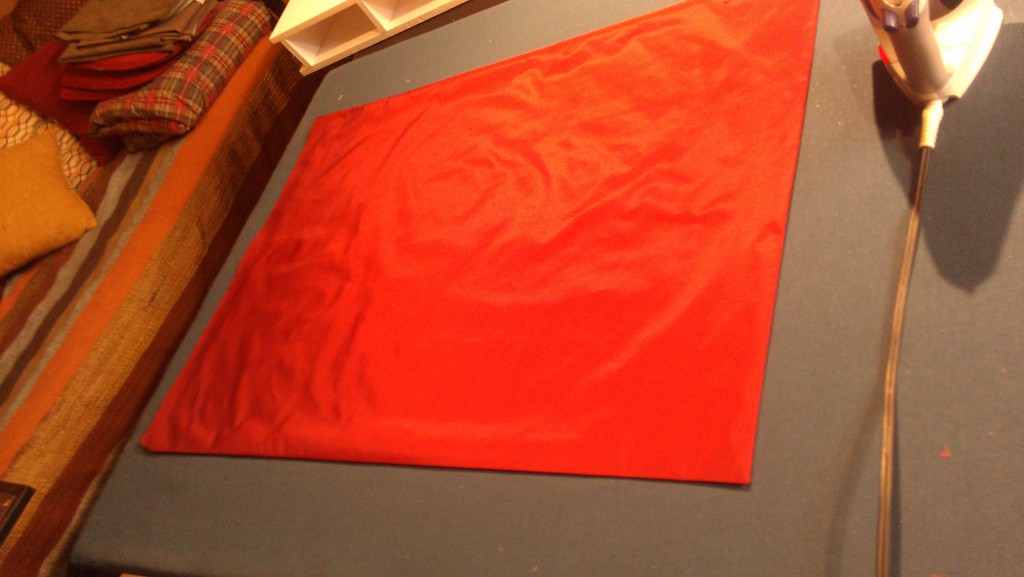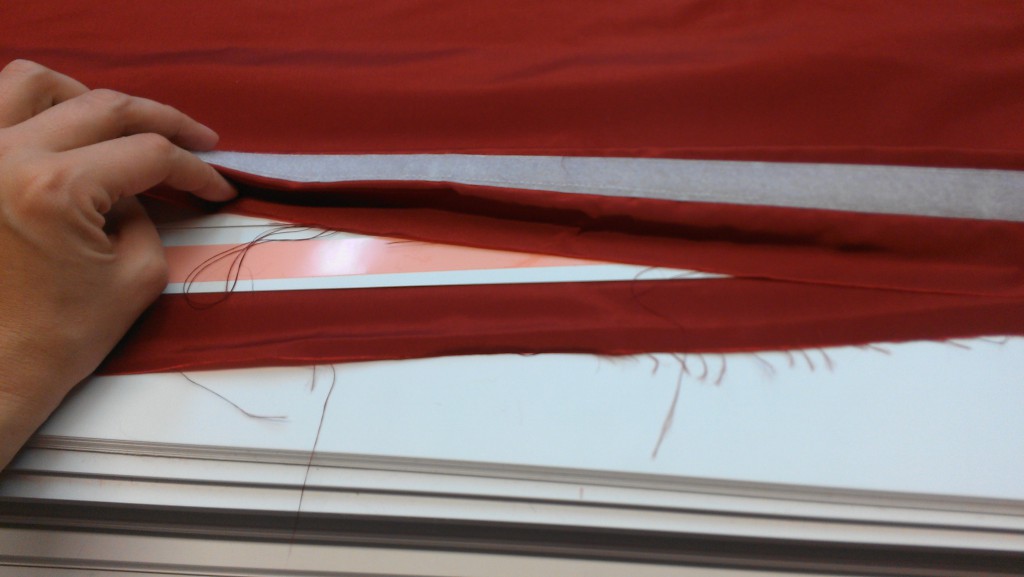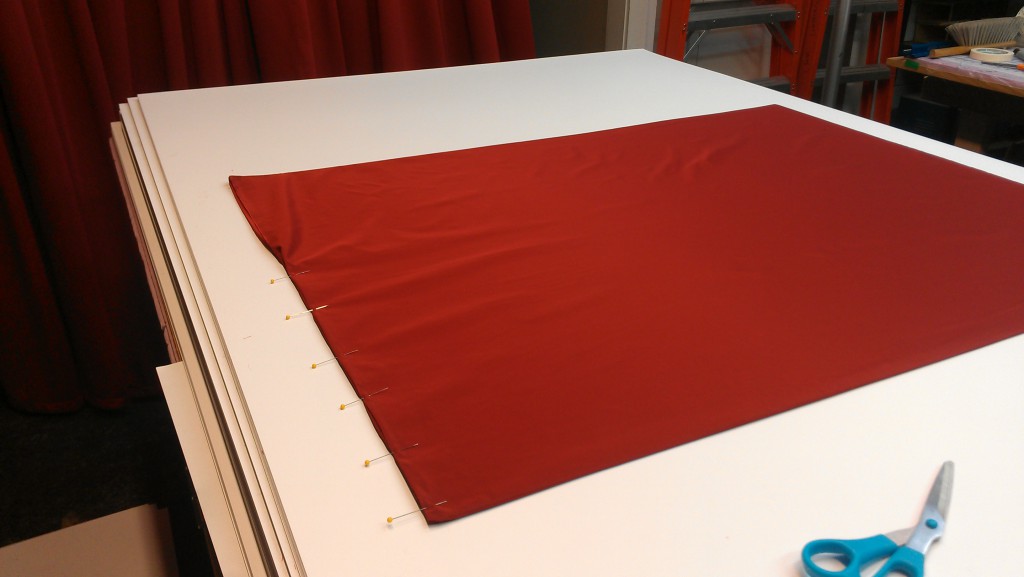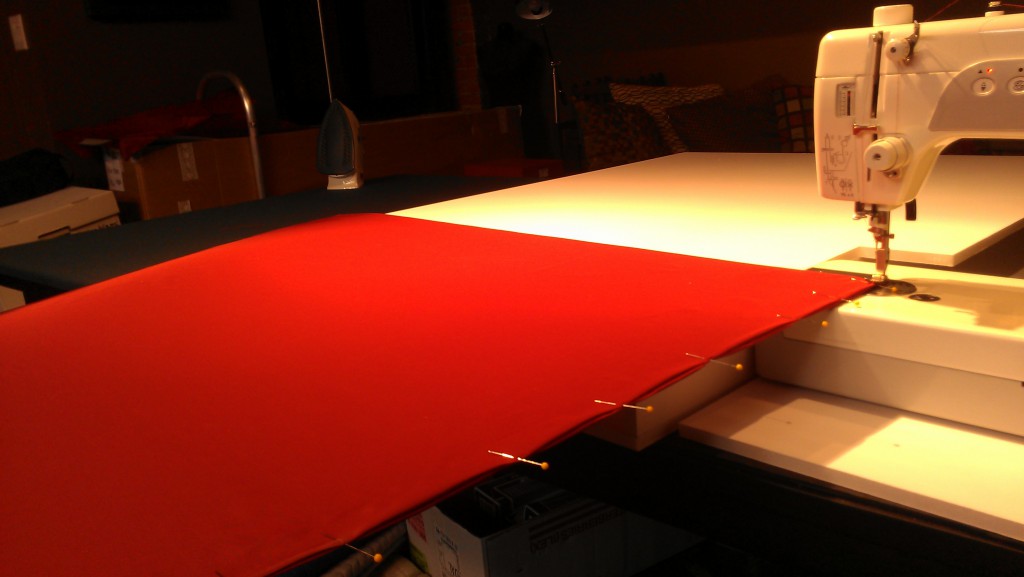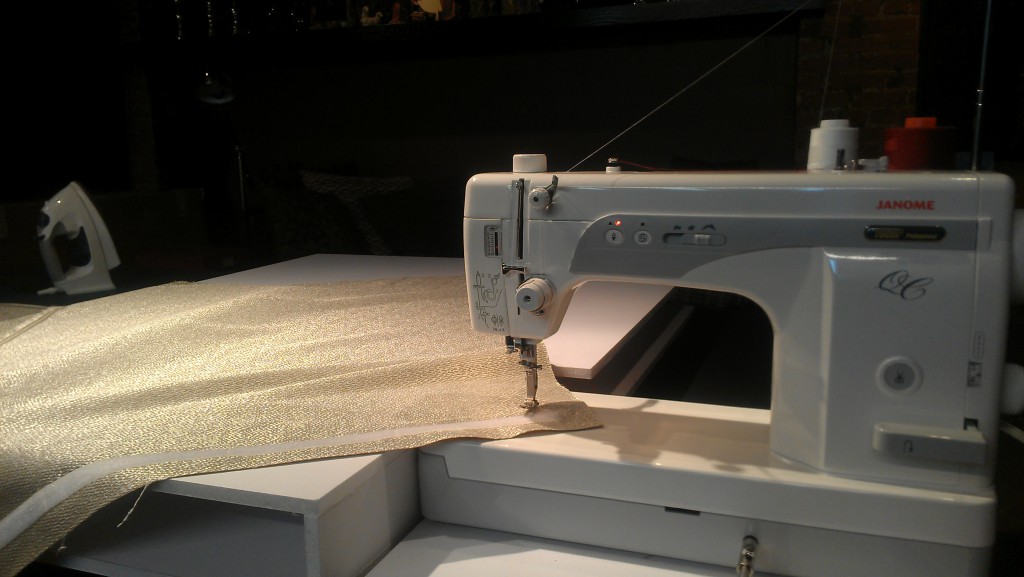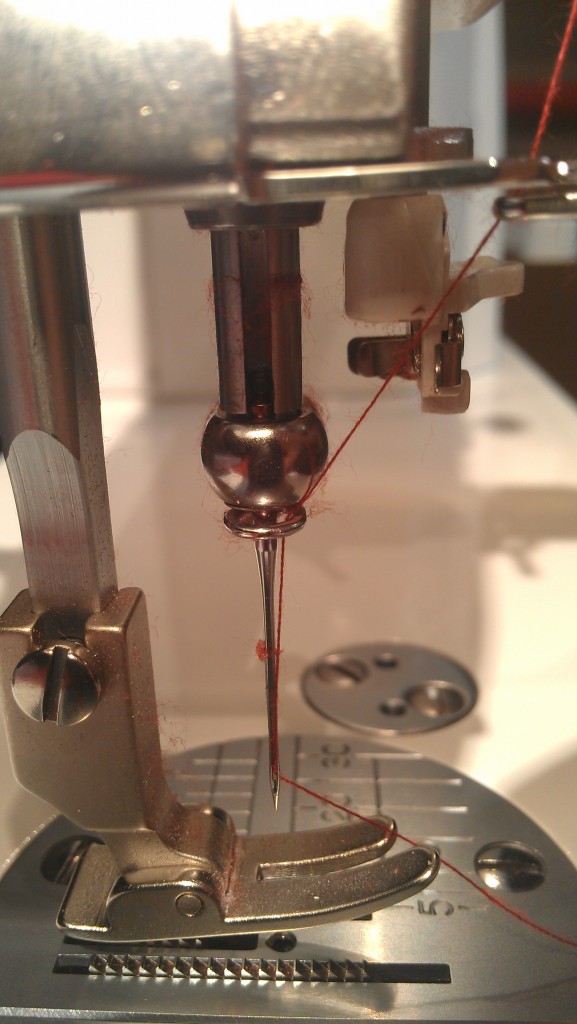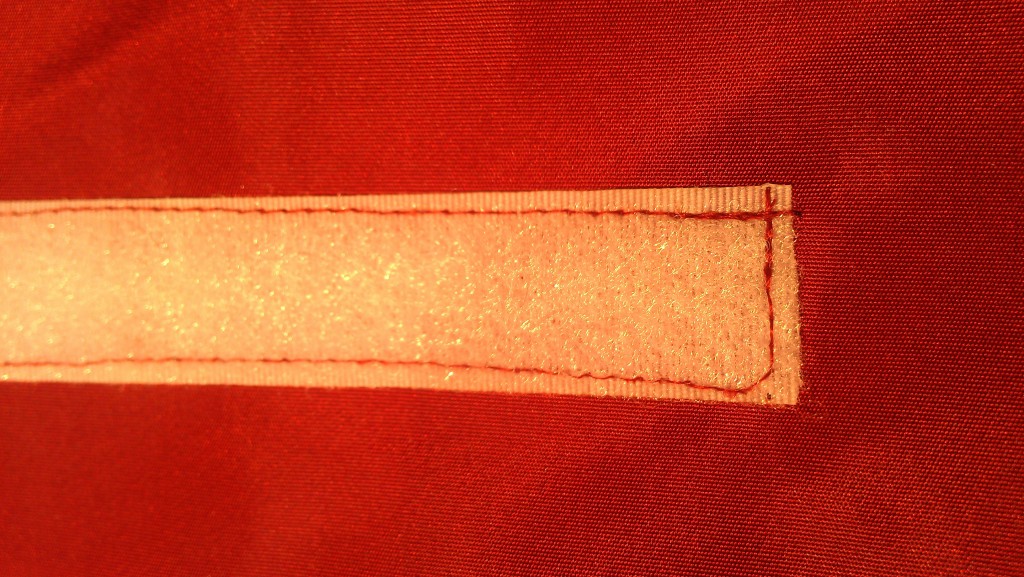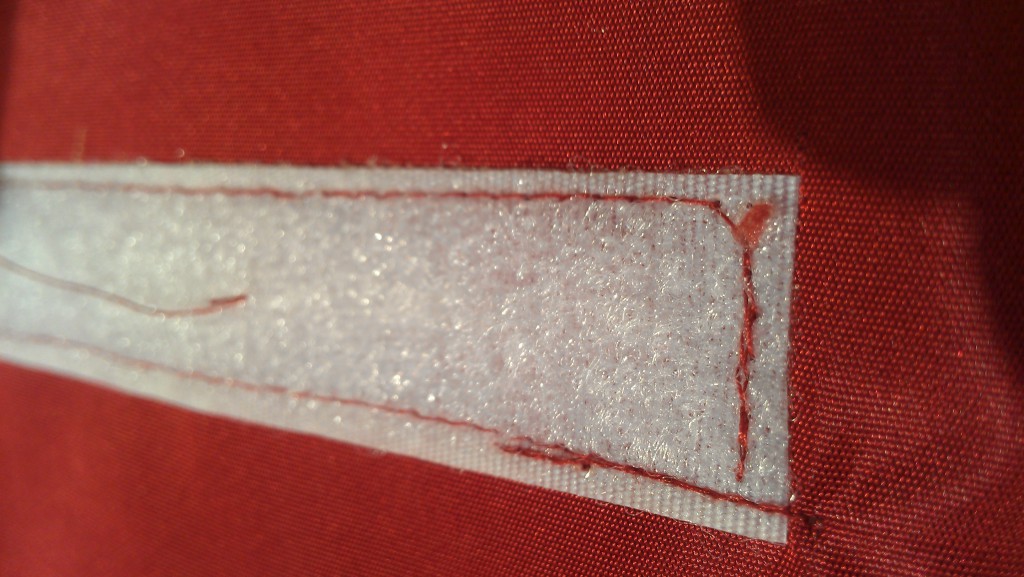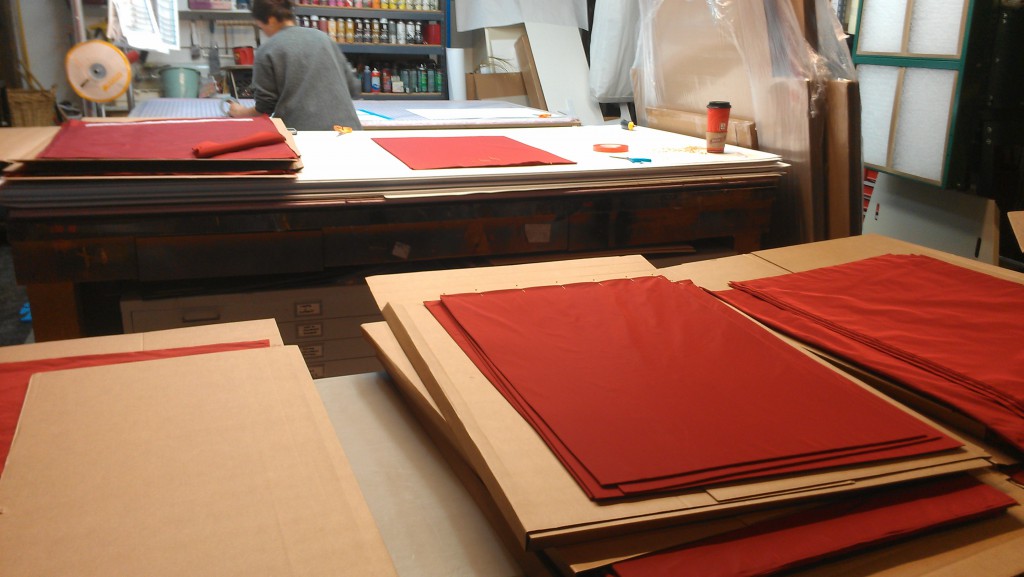
Monthly Archives: January 2013
Business Buffet Pants
I repaired the hem on these pants for a client and noticed a cool effect at the waist.
First View: side pocket lying flat–
Second View: 2-layered waistband; the upper layer slips quietly behind a beltloop into a casing made from the back of the waistband, where it hides some elastic that doesn’t visibly rumple the outside–
Third View: sneaky!–
Buffet pants you can wear to a business meeting!
A Lot of Thread
Here is a lot of thread:
This isn’t the largest quantity of thread I’ve bought in one go; I was actually sort of disappointed with myself. There was a half-off thread sale that coincided with a 10% total purchase coupon, so I stocked up and bought the store out of black, white, and brown. Which means that I can postpone setting up a wholesale account and buying it directly from the manufacturer for a little longer.
I actually prefer Maxi-Lock, but this is what Joann’s carries, so it’s more Toldi-Lock for now.
Velcro
Next round of velcro-on-Cartier-panels. This set is 330+ panels, so the new machine is pretty much broken in as far as sewing through glue.
I’ve been thinking about a name for the machine: perhaps a superhero, to go along with Jonah Hex, my serger. I considered The Flash, but I don’t think it would be readily clear that I’m referring to Wally, who dresses in red and wears a lightning bolt, rather than just something that is fast, without having to stop and explain to everyone:
Me: This sewing machine is called The Flash.
Other Person: Oh, because it’s fast.
Me: No, because it’s super.
Other Person: Oh, right.
I’m not sure that any other fast superhero has any clearer a name in regards to sewing machine nomenclature, so then I thought about naming it after the fact that it only does one thing, but it does it really well.
The Atom? But he’s also smart, and I don’t know how bright this machine is, after all. Elastic Man? That’s a big misleading.
The Green Lantern is definitely the one-trick pony of the Justice League; magic ring, and all he ever manages to imagine with it is a giant fist. I suppose he can also cut things when necessary, and that he can change his foot pressure.
If anyone confuses the name Green Lantern–
Other Person: Oh, like a decorative green lantern I would put in a yard or buy at Hobby Lobby in the perpetually half-off glass section?
–that’s their own fault, and I’m not explaining it. Though perhaps I should ask Larry what he thinks of the name before I christen it with a bottle of machine oil, as it is his sewing machine after all.

Wonder Woman is not amused. (Actually, this isn’t the Green Lantern I picture in my head, but I couldn’t find any handy shots of Jon Stewart making a fist, for some reason.)
Anyway, back to how Green Lantern handled the glue. Pretty well; the needle continues to not be particularly gummy. The bobbin case is only marginally sticky and it catches a very moderate amount of fuzz. The thread has a periodic tendency to break, and there seems to be some sort of intermittent issue with the tension, but complaining about that after getting 250 strips of sticky-back velcro into this project is pretty much complaining that my sewing machine isn’t magical.
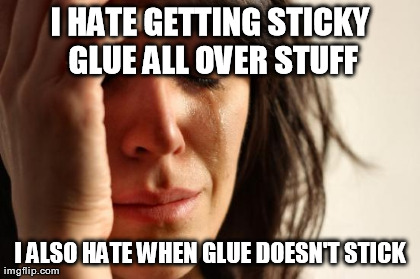
And now I’ve created this horrible meme that will live forever on the internet.

Hobby to Paid Work
What with my usual tendency toward synchronicity (or maybe just because it’s a big topic for sewers), here is someone else’s blog on taking sewing from a hobby to a job.
http://thelaststitch.blogspot.com/search/label/Setting%20up%20shop
Clothing Journey Part 2
Now, don’t get me wrong (continuing from my entry two posts ago); it’s not that I’m complaining about “having to” sew for a living–I’m attempting to publicly reason through what made me rush home from linguistics class to sew without a break back in college, and what it is that changed so that now there’s a temptation to take a break from taking a different kind of a break before getting back to work.
And don’t say “being 23,” because it’s that kind of attitude that puts bags under your eyes at midnight on your 29th birthday and makes you old when you’re old.
This woman is 70. To all those people who have ever said to me–or to anyone, for that matter–“Well, you’re not 20 anymore, what do you expect?” (though my first-person encounter with that sort of rubbish was at age 27, so what do YOU expect?), take a good long look at the above photo and then an even longer look at the following photo response:

I know a self-described “corporate whore” who does awesome art–my house is about 80-90% decorated with his stuff–who described the divide in college when all his artist friends started art-related careers, while he picked a money-related career. Now he does more art than any of them do.
That’s the danger of successfully turning a hobby into a job. It doesn’t take long before the thing you love becomes the thing you have to do.
Robert A. Johnson, in his book She describes the journey to maturity as starting out in childhood with unconscious perfection, shifting in adulthood to conscious imperfection. The final stage is conscious perfection, combining the best of both. I like to apply this model to pretty much anything that comes in 3 and happens across a timeline, and I posit that the hobby-to-job transformation exemplifies it.
To go off for a moment on a related tangent, I have met a lot of people who want to sew. When I was rolling in writing circles and telling everyone about how I was going to be a writer (which I still will . . . ), I met a lot of people who wanted to write. Get people talking enough, and you’ll hear about how people want to paint, but . . . who want to _____, but . . .
The thing is, if you want to write, you write. If you want to sew, you sew. If you want to paint, you paint. If you want to learn guitar, you play a guitar. Actually, what all these people want is not to sew, but to want to want to sew; to want to want to write, to want to want to paint.
There’s nothing wrong with this; nobody can do everything they want to want to do. Nobody has enough energy to actually want to do all of these things, and they wouldn’t be any good at any of them if they didn’t set aside the want-to-wants. (Though that previous statement does not apply to you if you only have want-to-wants; in that case, pick one and want it.)
I want to want to play the piano; I’ve wanted to want to play the piano for over two decades–I even went so far as to take a year of classes and to buy a nice keyboard and a lot of music books. I practiced periodically, but I never wanted to–I only wanted to want to, so now the closest I’ll come to playing a piano is hanging one’s guts on my wall and strumming them amusically.
I want to want to learn gymnastics. I want to want to be a martial arts master. I want to want to be a dead shot with some kind of projectile. I want to want to have an impeccably trained dog. I want to want to be able to sing. I want to want to keep a beat on a drum (I’ve heard it said that there are two kinds of people in the world–drummers and people who want to be drummers). I want to want to build elaborate furniture. I want to want to understand electricity and wiring. I want to want to be a chemist. I want to want to want to be able to hold a spider without going into convulsions.
So know that what I’m saying here is not a value judgment. It says nothing against you that you’d rather buy your clothes in a store than make them yourself. It says nothing against you that you don’t want to churn your own butter. It says nothing against you that you get your oil changed at a shop–or, if you do change your own oil, that you didn’t build your own car from scratch.
Back to sewing. First you want to want to sew. You admire fashions; you admire other people who sew; you buy fabric but don’t do anything with it; you talk about what you could do with it, what you will do with it; you think about buying a sewing machine, but you use the excuse that you don’t know what kind is best or they’re too expensive; you maybe even have a sewing machine, but you don’t know how to use it, and you don’t get around to learning. You think about at least sewing your own buttons back on your shirts when they fall off in the wash, but it just seems like so much work and hassle, and it’s easier to hire someone to do it. You roll around outside the edge of sewing, but you never cross the border.
When you really want to, you start figuring out a sewing machine, you start playing with patterns. Make a pillowcase. Pajama pants. Repair a tear that’s on a seam. Discover how easy it is to add darts to certain cuts of shirt and jacket, and go nuts. Everything’s exciting–OMG, I can cut out a pattern on the bias and it makes it drape completely different!
To take it from dabbling, wanting to dabble, or vague slightly dabbling to actually sewing even part time, you have to change your mind. There is a lot of tedium in sewing, and one of the big points I’ve heard people bring up against themselves personally being able to sew is that they don’t have the patience. You don’t sew because you have patience; you have patience because you sew.
I was a kid who grew up spending a lot of time sitting still, entertaining myself quietly, reading, drawing. I have an unusually high tolerance for sticking with a project for an extended period. But making a half dozen skirts all with 6 panels and 18 godets (triangles) sewn in between the panels in sets of three, could make the aspergheriest bean counter balk.
You try the trick where you see how many you can do in an hour, then try to break that record. You try counting down: there are 108 triangles. Yeesh. Okay, no, there are 18 in this skirt. Let’s start there. So you plow away at these triangles for a really, really, really long time, then stop to count how many are left. 14. Seriously? But I’ve been working on this forever. So you work on it for even looonger this time. Stop and count them: 9 left.
And you’ve just spent probably a quarter of your sewing time counting and recounting triangles instead of finishing a freaking skirt. Not to mention dwelling on the fact that you’re sewing triangles and getting quickly sicker and sicker of it.
What has to happen between counting triangles and wondering why you ever wanted to sew instead of just wanting to want to is a cognitive shift. There are any number of Zen anecdotes about the rice-preparing monks reaching enlightenment before the meditating monks; there’s something about repetition to enjoy (there’s even a Hot Chip song about it) but you have to change the way your brain works to make this possible. Since we can’t get into our own personal bios or locate the dos prompt, the most reliable way to do this is by doing it.
http://youtu.be/1mdgLn5BFRQ
Back to the three-part growth cycle. I suspect that pretty much every job provides the opportunity to get bogged down on level two.
I’ve never sold a house, but if I did sell one, I’d probably be pretty excited. I’d probably be pretty happy with my sales skillz for the next ten houses. A couple decades later, and do you still love your real estate job? Teaching kids all year, getting to know them, and then they move on and you start over, teaching the next round the same stuff. Year after year, same song thirtieth verse, a little bit louder and a little bit worse.
Feeding big cats at a sanctuary–how long until the excitement of feeding this guy wears off and you lose the wish that you could just cuddle him?

It’s easier to force yourself through the second stage for longer when you work for someone; when there’s someone else making you do it. When some of your time clocked in can be spent getting paid to go to the bathroom or playing minesweeper. This is why there are so many genius artists who can’t make a living; when you want to keep your attitude about art at stage 1 but get paid like you’re in stage 2, it’s not going to work.
The question is what does it look like to reach level 3? The confusing part is you can’t imitate anyone else who’s found it, because it’s going to be different for you; some people are going to get all the work done during the red part of the above graph, then relax in the yellow. Some people are going to have that same style of action, just without the crying part. So if you’re standing at level 1 and trying to imagine at yourself at level 3 and thinking you know what that looks like, I leave you with this picture to ponder:

Chinese New Year Sacks
Usually for these panels, I just stitch on the velcro, then someone else glues the fabric to the backing. This taffeta fabric chosen to decorate for the Chinese New Year was too thin and the glue left visible dark spots. So instead of wrapping the fabric around the styrene, we made the panels like bags with the styrene as an insert.
I laid the styrene panel on top of the fabric and traced around it, then stitched on the outside of the line with the fabulous new Speed Janome. (I need to come up with a better name for it–and don’t say it already has one. I don’t tell you to name your kids Tiny Human Jones; don’t tell me to call my sewing machine P1200.)
Snip the corners, turn it right side out, and poke the corners out with this corner-poking tool:
Press the pouch. Before:
After:
Eek, I ironed off the velcro! No, it’s on the other side. I had you for a minute there, didn’t I.
Don’t worry; I’m not going to justify that “question” with a question mark.
Double-sided tape to hold the velcro in place and pull the back fabric taut:
I cut the raw edges fairly close, then folded them inside and pinned:
Larry made an extended table for the sewing machine, which was necessary for sewing something this stiff that had to be kept flat.
Here is a shot of it being slightly more visible:
I broke into the Chinese New Year panels for some emergency velcro-sewing on some regular panels. There is a gap between the back of the sewing machine bed and the extension because the base didn’t take into account the width of the knee foot-raising lever.
Which I also had a hard time remembering to take into account. The first several panels, I snipped the threads with a physical scissors instead of the auto-snip scissors button. Since I associate my hand (upper body) with raising the presser foot and my foot (lower body) with making the machine run, trying to associate my knee (lower body) with raising the foot kept messing up my internal autopilot; I kept mixing up making the machine go with the knee-raiser and pushing the pedal with raising the presser foot. Other times, I would raise the foot by hand and by knee at the same time or confuse the fact that the knee raises the foot temporarily while the hand lever raises it until you manually lower it.
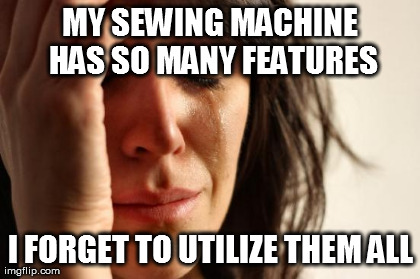
We needed a couple dozen velcro strips, which wouldn’t truly test the new machine’s ability to handle the X-treme glue (no sic), but it could start to give an idea, as well as mentally prepare Speedy for his real full-time job that does not include hours of sewing on luxurious taffeta.
Here is what the glue looks like collected on the needle:
That’s the accumulation from just one strip.
So far it does not seem to be getting down into the bobbin case or sticking to the bottom of the presser foot. Or getting into the feed dogs or lining the bottom of the needle plate.
These needles don’t really have much of an indent running down the shank, so the glue doesn’t build up in there. The side-loading needle so far seems to handle the glue and keep the thread away from it better than the usual front-loading needle.
One sort of problem I’ve noticed with this machine is its ability to corner:
And again, to show that this is not an isolated incident:
Though in this one, you can see where it’s trying.
Coming up slowly on the corners–and of course coming to a complete stop, raising the presser foot, then turning the fabric–does not seem to have any effect on its tendency to Tokyo drift.
Anyway, back to the New Year panels:
Because the process involves so many steps, and because doing all of one step before moving on to do all of the next step takes less time than cycling through all steps for one or for a small group, I tried to production-line as many stores at once as I could. They’re all divided up by very specific quantities and sizes–down to a half-inch difference between the panels for one store or another. So here is the mess of multiple stages going on and being kept carefully separate.
Continental Gin
Here are some shots from my old sewing studio at the Continental Gin building (which used to manufacture cotton gins). It was the corner space on the 3rd floor, and it was the only one that came with a built-in loft. Since then, I will not studio out of anywhere that I can’t build up.

The bricks are so old that every time a mouse sneezes, you can hear the skitter skitter of dust crumbling down all over your stuff.
I had just bought two rolls of these plastic sheets and was going through the process of putting it up everywhere behind all the existing stuff when I got the opportunity to move into my current space.

The reason the plastic looks like crap was because as I was installing it, this whole space was filled with shelves and piles of fabric. Also, it looks like crap because it’s plastic and it has to cover some really cool-looking bricks.
It was impossible to keep it not-filthy, though. This was after I pulled everything out of the closet and actually swept. From this photo, it looks like an abandoned building you’d find squatters in. Yup, that’s swept:

The roof of this place slopes in two directions, so my studio was actually the one in the building with the highest ceiling, and nearly the only one of its size with three windows. Which meant that at certain times of day, I would be blinded for several hours while trying to sew.
When I first moved in, the halls in my area were burgundy, and a nearby wall was yellow with windows made from glass doors whose trim was painted red. It was very bright and creative, which worked well, I thought, for an artist space. Eventually, everything was painted a nice, tedious shade of white for some reason. My studio was the only one that came with walls that weren’t white, not to mention floor.

The Clothing is the Destination
I’m sitting here with a lot of work to do, some pretty tight deadlines, and I’m drinking coffee and reading The Last Psychiatrist blog posts–each one promising myself this will be the last, then prolonging it by reading all the comments. Why? Because I’m all caught up on Regretsy posts. (Alas.)
As I try to analyze why am I so [lazy, unwise, etc.], I stop that train(wreck) in its tracks. As I know I am not a lazy person (and who/what IS a lazy person, anyway? How did they get like that? Is it inherent, learned, or something else?), what is it that is causing me to behave in the manner of a lazy person? What are the descriptions that spring to mind first as I try to MAKE myself do tasks involved in a business that started out as a HOBBY, as something I ENJOY? How much of this is an unconscious association of “work” as “unenjoyable,” as drudgery, as a means to an end?
The mental mix tape that gets new recordings with every job defines what it means to work, reprinted here with the tune taken out and bulletpoints for your convenience:
*Everything I get is last minute with tight deadlines; everyone wants their stuff back fast
*Everyone wants a piece of me at the same time and all the work piles up fast and sudden
*I’m not getting paid enough for this
*It’s hard
*It’s unrewarding
*I’m under appreciated
*If I were making __________, then I’d be excited about it
As far as freelance sewing goes, yes to the first two. No one thinks to buy a winter coat in the summer. They think of it in the winter. They think of it when it gets cold, and then they want one right away. No one thinks about the seam that’s ripping out in their favorite bathing suit when it’s freezing outside; they remember it 3 days before their Caribbean cruise. It takes a strange and orderly customer to think of having new garments started a season or more before they are necessary. And yes everyone thinks of what they want, after they needed to already have it, at the same time that everyone else thought of it. You can witness this phenomenon in every retail establishment by standing near the checkstands for a couple rounds. It’s a little uncannier when not in a physical establishment where you can cite visual cues or what-have-you, but it is the way things work. And a lot of those people, even if they don’t have any rush for their needs, still don’t want to have to wait in line, especially not an invisible one. As Vonnegut would point out, so it goes.
This is the nature of the beast, you don’t like it, find a desk job where you have one boss. Or perhaps stop being the exact same as that situation yourself–did I start D.’s winter coat before winter? No. Is it even done now? No. I’ve started working on the pattern, but apparently in the Asian coat-pattern books I got, XL, while it looks numerically to be big enough for him, isn’t even big enough for me. So it’s January and D.’s coat might be finished for next winter. Ah, well, the shoemaker’s children and the clothing designer’s significant other . . .

Notice the obligatory XXL sizing; this would still not be big enough. (Don’t tell D.)
You can’t change the external factors, like when clients call, or even what item you are working on. Yippee, another hem on something. The ONLY thing you can change is your perception. Why are hems unexciting? Why is menswear less rewarding than womenswear? Why did I decide this? Did I really get into sewing for the glamor?
Sewing is a behind-the-scenes thing and NOBODY knows how long it takes to do most things, even someone else who sews as a hobby. Like writing, it’s somewhat glamor-ish to people who like the idea of somebody writing or sewing or painting. Or sitting drunk at a typewriter in the kind of physical and mental condition that could cause a grown man to fall asleep on a radiator and injure himself. That’s only glamorous when you hear about it, but not when you’re there.
When you’re there, it’s a lot of work, and when I say I’m busy, I really am busy–even if I’m clipping my toenails to try to distance myself from how busy I am: gross national columnist, which is just another fabulous part of the glamor.
The idea that there is an intrinsic difference between pant hems and wedding dresses is the kind of college idealist, English Department garbage up with which I will not put. It’s the thing that caused the Professional Writing Department I graduated in to flee to the Journalism School to escape the English major’s crap about popular writing being intrinsically bad writing, or at least not as important as the rubbish he’s got at home soaking in its own Importance, Relevance, and Human Condition Defining juices in an anonymous filing cabinet. #end rant
The thing that is the SAME about pant hems and wedding dresses is how the people wearing the finished product feel about them.
In this Wal-Mart market of clothes too cheap to be made by non-starving Americans, the clients I get clothes-wise are generally people who can’t just go to a chain store and pick up something that either fits perfectly or is at least close enough. Aside from the very wealthy, whom I’ve seen get garments adjusted down to the quarter inch, almost pathologically, the people who go to the trouble and expense of getting their pants hemmed really need them to be hemmed. So when a pair of pants finally Fits, the person putting them on can be really freaking excited. Especially if it was some kind of specialty hem that not every alterations place can/will do. Then they’re pretty much as excited as if they got their wedding dress back fitting perfectly. I’ve even got one client who texts me periodically to tell me how happy he is in the clothes I fitted–my favorite text was when he was at an art show and “the best art here is these pants!”
Everything I’ve got on line right now will make someone happy or help someone in some way or solve some problem. It’s easy to look at the down side (these panels could have been done with a different material, this deadline didn’t need to be this short, the change in this garment from Before to After is too undramatic to bother with a before picture even if I remember to take one before cutting into it), and it’s easy to blame myself for being the kind of person who does that. But the problem started with changes in definitions that were too subtle. Do you remember when you stopped playing at washing clothes or doing the dishes and these activities became chores? Or when pushing around that popping-ball toy lawnmower turned into “Oh God, I have to mow the lawn again this weekend”? Why is “work” inherently un-fun? What makes it “work”? What is your unconscious definition of “work”? Like an infant who witnesses two adults fighting about something stupid and is told “Aww, that’s love” and who grows up to pick stupid fights with everybody it cares about, the older you get, the more definitions of what “work” is you add to your invisible mental dictionary.
Work is drudgery; work is underpaid; work is under appreciated; work is ___negative adjective___. Am I under appreciated? Hell no! One of my regular employers, when I let him know I hadn’t gone in to a different job that day, as originally planned, asked if I had called in because I was too awesome to work. And I could go on. And I’m not mentioning this to increase my accolades via internet audience approval, but to point out that the absurdity of the little voice in my head that believes it is under appreciated isn’t just wrong because I am a special snowflake, but because in objective reality I am rarely under appreciated.
Yet this is an internal definition of work. The problem is the gap between the work done and the appreciation; it’s also the greater importance put on external vs. internal appreciation. The working part is unappreciated, the finished item is appreciated; I’m being appreciated not for what I did, but the end product–not the doing, but the thing, which makes the doing hard, and makes the doer frustrated at the thing for getting all the accolades.
You can’t change the temporal gap between work toward a goal and the completion of the goal. Zen anecdotes about the climb up the mountain being more important than the destination (try telling that to a customer) aside, the question is how to make your personal, internal perception of the journey AND the destination of equivalent value. How to make the DEFINITION of the journey/ work something other than what it has currently, accidentally become.
The idea that the journey is as important or more so than the destination and for the same reasons is the kind of thing you see reposted on people’s facebook pages on those blurry photos of pretty girls or mountains or pretty girls on mountains, with some sort of trite text printed in a script-y font on top of it.
No it’s not! I didn’t go to Wisconsin to fly on a plane or to have trouble at the rental car desk; I went there to see the House on the Rock. Everything in the middle was nice and all, but the destination was the thing. Otherwise I could fly on a plane to an airport, look around the gift shop, and hop back on a plane home. Don’t tell me the journey is the POINT. There’s something more to it than that; that’s the kind of new-agey rubbish that confuses people who want to be new-agey but can’t quite put their finger on why it’s not working.
The point of making clothes is to have clothes at the end of the project; it is not to sew. Again, try telling the opposite to a customer. The existential trouble is the part where you have to sew to get to the clothes, a thing which is sometimes/always/never fun, and how to change the definition of THAT to like THAT.
The trick is to change the definition of “sewing” as “work” and/or (probably and) to change the definition of work from all the things you’ve accumulated over time at all your crap jobs working as a waitress/ store clerk/ assistant to a dragon lady/ cashier/ office monkey/ etc.
Why was washing toy dishes fun when you were a kid?

